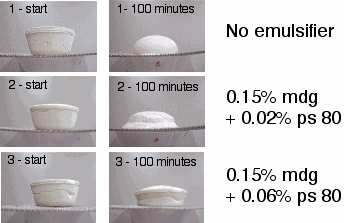Ice Cream Structure
28 Ice Cream Meltdown
One of the important manifestations of ice cream structure is its melt-down. When you put ice cream in an ambient environment to melt (as in a scoop on a plate), two events occur; the melting of the ice and the collapse of the fat-stabilized foam structure. The melting of the ice is controlled by the outside temperature (fast on a hot day) and the rate of heat transfer (faster on a hot, windy day). However, even after the ice crystals melt, the ice cream does not “melt” (collapse) until the fat-stabilized foam structure collapses, and that is a function of the extent of fat destabilization/partial coalescence, which is controlled mostly by the emulsifier concentration, for reasons we have just described above.
This is shown in the diagram below, which shows ice cream sitting on a mesh screen at ambient temperature:

You can see above the increased amount of shape retention and slowness of melt that comes from the added emulsifiers, particularly polysorbate 80.

